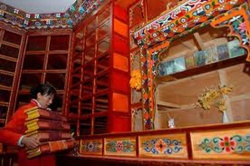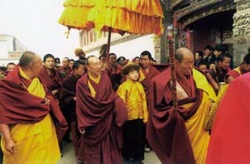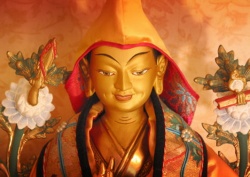Tsong Khapa's Reform
by John Powers
One of the main goals of Tsong Khapa's teaching, writing and practice was the reform of Tibetan Buddhism. He was greatly concerned with what he perceived to be major lapses in monastic discipline, unclear thinking on exoteric and esoteric topics, and a decline in tantric practice. Part of his reform program was the creation of a new order which, likes its founder, has traditionally stressed the importance of strict adherence to the rules of Vinaya, the importance of comprehensive study of Buddhist thought, an reformed tantric practice that accords with the vows of monks.
The Formation of a New Order, Two Main Disciples
In the late thirties he had a vision of Manjushri, who confirmed that Tsong Khapa had directly perceived emptiness and there was no longer any need for him to ask for advice on this topic. Manjushri then counseled Tsong Khapa to continue to teach in accordance with the systems of Nagarjuna and Atisha. Shortly after this, Tsong Khapa traveled in areas south of Lhasa, and at this time he met his future disciple Gyeltsap Darma Rinchen (1364-1432), who at the time belonged to the Sakya order and was already regarded as a great scholar and debater of that tradition.
The first meeting occurred when Tsong Khapa was preparing to give teachings. Gyeltsap openly challenged Tsong Khapa's authority by sitting on the throne that had been prepared for the lectures, but as Tsong Khapa begun to speak, Gyeltsap realized that the master's understanding far surpassed his own. He found that Tsong Khapa answered questions that had long troubled him, and as the lecture progressed he began to realize that he had been presumptuous in taking Tsong Khapa's seat. Humbly offering three prostrations to the maser, he took his place among the assembly. He later became one of Tsong Khapa's two greatest disciples. The other was Kedrup Gelek Belsangpo (1385-1438), who had become his follower several years earlier. After Tsong Khapa's death, these two carried on Tsong Khapa's system and institutionalized it, assuring that it would continue and flourish. Founding of the Ganden Monastery, Drepung and Sera
Tsong Khapa conceived the idea of inaugurating a yearly religious festival that would begin at the Tibetan Year (Lo Sar). The Great Prayer Festival, or Mon Lam Chen Mo, is still celebrated today in Tibetan communities and is one of the major religious events of the year.
After the first Mon Lam was celebrated, several of Tsong Khapa's disciples requested that he curtail his travels. At this time he was fifty-two. They proposed to build a monastery for him, and he agreed. Tsong Khapa prayed before an image of Shakyamuni for advice concerning the site of the monastery and was told to build it near Lhasa, in the area of Drokri. When it was built, he named it Ganden (the Tibetan translation of the Sanskrit Tushita), which is the legendary abode of Maitreya, the next buddha.
Tsong Khapa traveled to the site of the future monastery with one of his disciples, Gendun Druba (1391-1474), who was posthumously recognized as the first Dalai Lama. Gendun Druba appointed two other disciples to oversee the construction, and the main buildings were completed within a year. The monastery was officially opened in 1409.
Ganden later became a huge monastic complex, housing as many as 4,000 monks. The founding of this monastery was followed by the founding of Drepung in 1415 and Sera in 1419, both also near Lhasa. Ganden, Drepung, and Sera became the three principal monasteries of the Gelukpa school and were the lineage's primary seats of power. They were ransacked by the Chinese army in 1959, and Ganden was bombed into rubble. All three monasteries have been rebuilt in India, where they continue the scholastic and meditative traditions established by Tsong Khapa. The Continuation of Je Tsong Khapa's Tradition, Kedrup and Gyeltsap
Tsong Khapa's work was continued by his two greatest disciples, Kedrup and Gyeltsap. At the request of the other disciples, Gyeltsap ascended the throne of Ganden, indicating that he was recognized as the primary successor to Tsong Khapa's lineage. He held this position for twelve years until his death. During the course of his life, he wrote a number of important treatises, and his collected works are contained in eight volumes. Gyeltsap was succeeded as "throne holder of Ganden" by Kedrup, who retained the position for seven years until his death at the age of fifty-four. These two lamas came to be regarded as the "spiritual sons" of Tsong Khapa and are commonly depicted sitting on either side of their master in thankas and other religious paintings.
Growth of the Tradition
During the following centuries, the fortunes of the Gelukpa school rose quickly, mainly because it continued to produce an impressive number of eminent scholars and tantric adepts. The school attracted growing numbers of novice monks and built new monasteries, such as Tashi Hlunpo, which was founded in 1445 by Gendun Druba. This later became the seat of the Panchen Lamas, who are second only to the Dalai Lamas in prestige in the Gelukpa school. Gelukpa monastic institutions grew and flourished, and these began to attract students from all over the Tibetan cultural area.
The Age of Dalai Lamas
The third Dalai Lama, Sonam Gyatso (1543-1588) was discovered amongst the Mongols. He was the grand son of Altan Khan, one of the most powerful Mongol chieftains. This powerful connection between the Mongol khans and the Gelukpa school initiated a long-standing bond between the two groups.
After the defeat of the last ruler of Tsang providence by Gushri khan in 1642, the victorious khan appointed Ngawang Losang Gyatso (1617-1582), the fifth Dalai Lama, as temporal and spiritual leader of Tibet. The fifth Dalai Lama (the Great Fifth as he is usually called) proved to be an able statesman as well as an important religious figure, and he consolidated the rule of the Dalai Lamas, who continued to be recognized as the rulers of Tibet until the Chinese annexation of Tibet in 1959. Scholars
The Gelukpa school has been able to produce a succession of eminent religious leaders, people who embody the ideals of scholarship and meditative practice initiated by Je Tsong Khapa. Among these are the great scholar Jamyang Shayba (1648-1721), who wrote some of the most influential Gelukpa scholastic literature, and his reincarnation Gonchok Jikme Wangpo (1728-1791) , who is best known for his Precious Garland of Tenets and his seminal work on the bodhisattva levels and the five Buddhist paths, entitled Presentation of the Levels and Paths, Beautiful Ornament of the Three Vehicles.
Other important figures include Jang Gya (1717-1786), who also wrote an influential "Presentation of Tenets", Ngawang Belden (b.1797), who wrote an important commentary on Jamyang Shayba's Great Exposition of Tenets, and Pabongka Rinpoche(1878-1941), a renowned scholar and debater. Today
Tsong Khapa's tradition of scholarship and meditative training continues today in the Gelukpa monasteries that have been rebuilt in India, as well as in centers in Europe and North America. The present Dalai Lama is perhaps the greatest living embodiment of the tradition's intersecting ideals of intellectual achievement and tantric training. HH Dalai Lama is viewed by the overwhelming majority of Tibetans as the greatest symbol of all that is best and most worth preserving in their culture, and he impresses people who meet him with his unusual blend of genuine saintliness and humility, profound understanding of Buddhist thought, and meditative realization.


